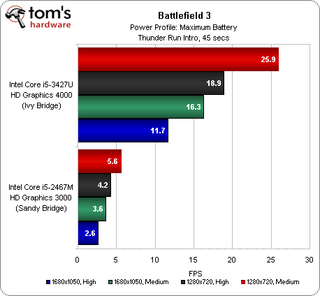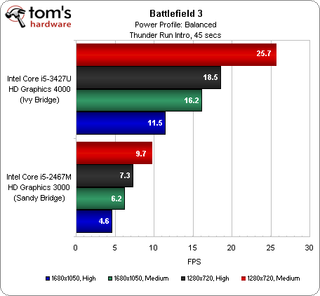Second-Generation Ultrabooks: Faster And Cheaper With Ivy Bridge
Benchmark Results: Battlefield 3
If you want a quick recap of the hardware composing Intel's HD Graphics 4000 engine, see page three of our Intel Core i7-3770K Review: A Small Step Up For Ivy Bridge. Briefly, the Ivy Bridge architecture adds up to four execution units (totaling 16), along with a number of performance optimizations that yield better frame rates than the HD Graphics 3000 solution on many Sandy Bridge-based CPUs.
The Core i5-3427U in our reference Ultrabook boasts an HD Graphics 4000 implementation that runs as fast as 1.15 GHz, and scales down as low as 350 MHz. Intel's Core i5-2467M shares the same ceiling and floor. Because the Sandy Bridge-based part employs HD Graphics 3000, though, we can expect it to be substantially slower.
We can see Ivy Bridge's advantage in a game like Battlefield 3, though the absolute performance you see is closely tied to the power profile you select (as we've seen in past reviews). These profiles are controlled independent of Windows' settings. Notebooks based on Intel platforms offer three choices: Maximum Battery Life, Balanced (the default), and Maximum Performance. Each profile presents a different balance between performance and battery life.
The Intel-built reference design doesn't seem to have profiles properly implemented, which is why the Core i5-3427U's performance doesn't change. Even with the Core i5-2467M-based Ultrabook running at its Maximum Performance profile, though, HD Graphics 4000 delivers as much as 2.5x-better performance. It's only a shame that Intel's graphics implementation isn't quick enough to make any tested resolution really playable. Faster though it may be, the Ivy Bridge architecture maxes out running mainstream games at most.



Stay on the Cutting Edge
Join the experts who read Tom's Hardware for the inside track on enthusiast PC tech news — and have for over 25 years. We'll send breaking news and in-depth reviews of CPUs, GPUs, AI, maker hardware and more straight to your inbox.
Current page: Benchmark Results: Battlefield 3
Prev Page Benchmark Results: iTunes Next Page Benchmark Results: Low-Resolution 3D Performance-
sam_fisher It seems that Ivy Bridge's lower TDP and its HD 4000 comes into its own in the notebook/ultrabook market more so than the PC/gaming one.Reply -
sam_fisher crisan_tiberiuthey should use HD 4000 on every intel CPU, i dont get it why they dont ...Reply
The integrated graphics is built into the processor die and the changes between the HD 3000 and 4000 are physical changes, so they can't just change them without changing the whole CPU.
-
mayankleoboy1 crisan_tiberiuthey should use HD 4000 on every intel CPU, i dont get it why they dont ...Reply
Pricing, TDP, segmentation and PROFIT -
crisan_tiberiu sam_fisherThe integrated graphics is built into the processor die and the changes between the HD 3000 and 4000 are physical changes, so they can't just change them without changing the whole CPU. Yes, i know that :)) but when they designed IVY they should have designed every chip with the HD 4000. The HD 4000 is still outperformed by Liano iGPU if you remember...Reply -
tomfreak Cant u put an older/previous generation desktop and benchmark against it? I cant or couldnt get how a fast a 2.0GHz Ivy vs a similar Nehelem Desktop CPU vs desktop core 2 duo CPU. Many of us buy notebook to replace desktop for casual use, we would like to know what it can do vs our old desktop.Reply
Besides get some older AAA games to bench, nobody play BF3 at Ultra books with HD4000. We wanna see what old games we can max out @ full resolution. -
silverblue I think AMD missed a trick with Llano. Instead of throwing four lowly clocked cores at a mobile processor, perhaps two higher clocked cores would've made much more sense. That way, they could possibly sport a higher clock GPU as well within the same TDP.Reply
Trinity's lower powered, higher clocked cores already look to have partly made up for this, but until the 17W variant comes along, there's no real indication of how it'll measure up to IB ULV. However, we do know that AMD pairs the slower GPUs with the slower CPUs and vice versa, so there's little chance of a, say, 2C/2T/1M CPU with the 7660G GPU. -
DjEaZy ... ok... you compare the Llano to Sandy/Ivy bridge in CPU performance, but not in GPU performance? and why not Sandy/Ivy Bridge to Trinity?Reply
... and Adobe Photoshop CS 5? not CS 6?
Most Popular

